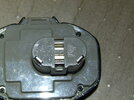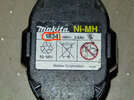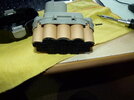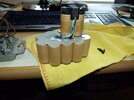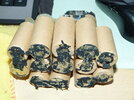Hi
Can anyone out there help me please.
I’ve got a Makita 1834 18v 2.6Ah Drill/Driver and the battery pack wont charge, not realising at the time I left the battery pack too long between charging’s as I’ve always used plug in tools before.
I found out about trying to jump start it but its still not working, anyway I thought I would have a go at trying to fix it, well its either that or bin it.
I’ve taken the plastic casing off the battery pack and can see 15 paper wrapped battery cells; size wise they measure 43mm high x 22.5mm diameter.
On testing each one with a multimeter 14 of them gave a reading of 1.37 volts, the 15th one gave no reading at all, so I assume it’s a dead cell.
I’ve been looking on the internet in the UK and have found paper wrapped cells 1.2 volts 3Ah but not 2.6Ah
Questions:
Will it be ok to replace the 2.6Ah dead cell with a 3Ah one??
ie. will the drill still work??
Will the battery pack still charge in the charger which is CH. P/N 630376B7
Makita DC1804F 7.2-18V, it came with the Drill/Driver??
My thanks to anyone who can help
Clive
Can anyone out there help me please.
I’ve got a Makita 1834 18v 2.6Ah Drill/Driver and the battery pack wont charge, not realising at the time I left the battery pack too long between charging’s as I’ve always used plug in tools before.
I found out about trying to jump start it but its still not working, anyway I thought I would have a go at trying to fix it, well its either that or bin it.
I’ve taken the plastic casing off the battery pack and can see 15 paper wrapped battery cells; size wise they measure 43mm high x 22.5mm diameter.
On testing each one with a multimeter 14 of them gave a reading of 1.37 volts, the 15th one gave no reading at all, so I assume it’s a dead cell.
I’ve been looking on the internet in the UK and have found paper wrapped cells 1.2 volts 3Ah but not 2.6Ah
Questions:
Will it be ok to replace the 2.6Ah dead cell with a 3Ah one??
ie. will the drill still work??
Will the battery pack still charge in the charger which is CH. P/N 630376B7
Makita DC1804F 7.2-18V, it came with the Drill/Driver??
My thanks to anyone who can help
Clive

